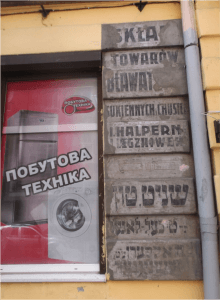FRINGE Centre blog series: ‘E’ for Elusiveness
By tjmsubl, on 7 January 2016
In the sixth of our series of blogs celebrating the launch of the UCL SSEES FRINGE Centre, Uilleam Blacker considers the elusive pasts hidden in the fabric of many east-central European cities.
There are cities in East-Central Europe – like Wrocław, L’viv or Kaliningrad – which were transferred from one state to another after World War II. As a result of the decisions to redraw borders that fell at Yalta, these cities had their populations deported, and new inhabitants forcefully resettled to them. Thus, German cities became Polish or Russian/Soviet, and predominantly Polish ones became Ukrainian, Belarusian or Lithuanian. The Holocaust also played its part in this drastic and violent urban reconfiguration, destroying the large Jewish communities of cities across the region.
Cities are living records of those who build them and live in them. In literature, from urban cultural theory to popular fiction, they are endlessly compared to archives, libraries, or palimpsests: cities are treated by those who represent and study them as memory texts that retain a chaotic, often fragmented record of the past, a record that is constantly reinvigorated, edited and refined. Yet what happens when the previous writers, librarians, and archivists of this urban text are dead or deported, and replaced by new custodians who may not know the language in which the text is written, or who may, indeed, fear and resent what is written in that language?
In extreme, traumatic cases of urban displacement, such as those experienced across east-central Europe after the war, urban memory connected to a given city fades to the margin, becomes erased, almost invisible. These memories are truly elusive, frustrating and evading those who may wish to find them. This feeling of frustration can be found in the work of the writer Igor Pomerantsev, who was born in Russia but brought up in the western Ukrainian city of Chernivtsi, which before the war was part of Romania and home to an extremely diverse population. Pomerantsev describes how the post-war Soviet generation in Chernivtsi ‘could not feel the ground beneath our feet… we did not understand what golden veins we trampled, what priceless ruins we roamed among’.[1]
Pomerantsev’s was not a generation of young intellectuals that was ignorant through choice, however – they had, in Pomerantsev’s words, ‘been deprived of memory’. The pre-war pasts of cities like Chernivtsi, which raised memories of the old, bourgeois central Europe that had been characterised by both national autonomy and multicultural coexistence, were seen as a direct threat to the monolithic, socialist post-war order. State-sponsored campaigns of physical erasure of the pre-war past from the urban fabric were the norm across the region, and churches, cemeteries and monuments were repurposed, flattened or removed, while ‘foreign language’ inscriptions were carefully chiselled from facades.
And yet, true to the multiple meanings of the word ‘elusive’, these ‘other’ pasts have also showed a remarkable ability to parry the blows of those who would wish to destroy them, refusing to be entirely erased. As the Ukrainian writer Yuri Andrukhovych puts it, in reference to his native Ivano-Frankivsk (pre-war Polish-Jewish-Ukrainian Stanisławów), the otherness of cities has a propensity to be ‘unexpectedly revealed’ in the cityscape:
The renovation of a building known for as long as Soviet memory could recall as ‘Desert-Bar’ unexpectedly revealed its Polishness. From under the newest layers of plaster appeared other letters, other graphics, other words. Like the beautiful and today entirely unnecessary word ‘tapicerja’ [upholstery – UB]. […] I dearly love those inscriptions that peer our from every possible hole, every crack in the foundations, from under thresholds, from the unconscious of the city.’[2]
As the observations of Pomerantsev and Andrukhovych show, the inherent elusiveness of urban memory as manifest in the fabric of the city is simultaneously a product of erasure and yet also a guarantee of resistance to that erasure. This tension has inspired a whole generation of east-central European writers, artists and memory activists to compulsively and exhaustively examine and re-examine the cities in which they live, producing one of the most compelling phenomena in European urban culture of recent decades.
[1] Igor Pomerantsev, Czernowitz, Chernovtsy, Chernivtsi (Kam’ianets’-Podil’s’kyi: Meridian Czernowitz, 2012), p. 139.
[2] Jurij Andruchowycz [Iurii Andrukhovych], ‘Tu i tylko tu’, in Jurij Andruchowycz, Ostatnie terytorium. Eseje o Ukrainie (Wołowiec: Czarne, 2002), pp. 13-20 (14).
Note: This article gives the views of the author(s), and not the position of the SSEES Research blog, nor of the School of Slavonic and East European Studies, nor of UCL.
 Close
Close


